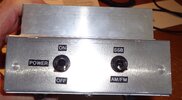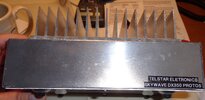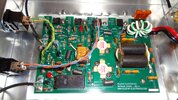To me, this board screams of parasitic oscillation...
The layout - too ordered - well thought out, but not in the approach of RF and it's needs in mind, more like ease of assembly and repair. - which raises a question about the builder, that being said;
NO - I'm not trolling just making an observation.
When you have trace layouts that structured, RF is a lot like water, takes the easiest path to get there, this board is a clean layout - looks nice to the eyes, but the RF path needed to reduce the problems of reactive elements in the pathways, isn't there - potential problems are evident.
Anyone whom has done their own amps or have had to chase down impedance bumps, squeals and ground loops knows this - and these boards are not setup to provide the best and most direct pathways for RF pipelines.
Ever try to work on strip line? This is what amazes me about him, he knows these problems exist and with a plastic enclosure this may have been his saving grace - not shielded so you have the initial tuning to accommodate the RF path (but do your calculations in the effort of less inductive effects along the pathway) - but woe be to they that place this too close to another noisy RF spot in their vehicle.
I've already had to work on several T/S and Palomar amps that the customers, in order to provide clearance UNDERNEATH their vehicles seats - have removed the covers of their amps and have generated other issues around the running amps with covers removed - a different SWR mess and beast can occur from this.
Although someone can think of this as a hilarity, but a bad amp can leak so much RF out of it's system they can set off an Air bag - which one customer visit at the shop did have occur - at least not admittedly at first - only when the amp was removed could it bee seen.
You can blame the wiring, or the proximity - but either way - my approach to plastic cases and their protection they can provide, I can only caution you.
- - the heat can soften, they can stink
- - and crack from the abuse they will get sitting in a vehicle
- - Bouncing around or bolted - can it hold up to accelration and torque problems in ordinary driving let alone highway...
- - Thermally stable plastic or not - whether it would be a sunny hot day, or the cold of winter - are you sure you can trust this build construction?
As said earlier - not to troll, just pointing out that this uniqueness of the design may be the reason it does work because of the layout and ease of serviceability .
They had to test and refine it to make it work. - but is it the best concept you can provide a customer?



